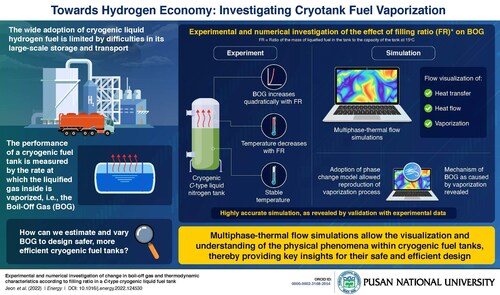The researchers have investigated how vaporization and heat flows within the fuel tank vary according to the tank filling ratio
BUSAN, South Korea, Jan. 3, 2023 /PRNewswire/ — Hydrogen is widely considered as the fuel of the future. However, there are still challenges and safety limitations to improving the storage efficiency of liquefied hydrogen fuel when it comes to its large-scale, commercial transport and storage. Now, researchers from South Korea have experimentally and numerically investigated the heat flows and phase changes within a cryogenic fuel tank using multiphase–thermal flow simulations, to reveal key insights for their safe and efficient design.
Rising climate change concerns have emphasized the need to switch over from fossil fuels to alternative energy sources. Of these, hydrogen fuel is considered the most promising for the transportation industry. Presently, hydrogen fuel is transported as high-pressure gas in specialized tanks. But this technique is both inefficient and poses serious safety concerns. To address this challenge, researchers are increasingly looking at the use of liquified hydrogen fuel.
Liquified hydrogen fuel can only be transported in cryogenic tanks (cryotanks), which maintain temperatures below -253⁰C—the boiling point of hydrogen. Despite thermal insulation, the liquefied fuel in a cryotank experiences a degree of vaporization. The flow rate of vaporization is measured as “Boil-Off Gas (BOG).” Too high BOG can result in excess internal pressure inside the tank, leading to cracks and fissures. This makes understanding and controlling BOG a key factor in cryotank design.
To this end, a research team, led by Professor Jong-Chun Park of Pusan National University in South Korea, have investigated how BOG varies with another critical design parameter called tank filling ratio (FR)—the ratio of the mass of liquefied fuel in the tank to the capacity of the tank at 15⁰C. “In our study, we performed experiments, as well as simulations, to analyze the thermodynamic characteristics of the tank,” says Prof. Park. The study was made available online on 24th June 2022 and published in Volume 255 of the Energy journal on 15th September 2022.
From their experiments, the researchers found that BOG increases quadratically with FR. They also found that while the temperature within the liquid phase remained constant, the temperature of the vapor phase decreased non-linearly with FR. The researchers then performed multiphase-thermal flow simulations of the tank using computational fluid dynamics. This allowed them to easily visualize the heat transfers, thermal flows, and vaporization within the vacuum-insulated tank. “We adopted the Rohosenow’s phase change model for the simulations, which allowed us to reproduce the vaporization process within the tank. From our simulations, we were finally able to reveal the mechanism of BOG as a result of vaporization,” explains Prof. Park. The researchers validated their simulations using the data from the experiments conducted through a collaboration with Daewoo Shipbuilding & Marine Engineering Co., Ltd. (DSME).
The multiphase-thermal simulation technique used here, could accelerate the design of safe and efficient commercial cryotanks for liquefied hydrogen. The applications of this research are wide-ranging, from automobiles and aerospace to offshore powerplants, thereby making it a critical step forward for the realization of a hydrogen-centered society.
Reference
Title of original paper: Experimental and numerical investigation of change in boil-off gas and thermodynamic characteristics according to filling ratio in a C- type cryogenic liquid fuel tank
Journal: Energy
DOI: https://doi.org/10.1016/j.energy.2022.124530
*Corresponding author’s email: jcpark@pnu.edu
About Pusan National University
Website: https://www.pusan.ac.kr/eng/Main.do
Media Contact:
Jae-Eun Lee
82 51 510 7928
351290@email4pr.com
SOURCE Pusan National University


